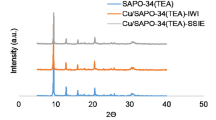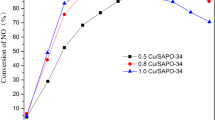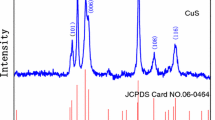Abstract
Two different routes of synthesis were followed in order to compare the surface properties of two Cu-SAPO-34 catalysts. The direct copper incorporation during the hydrothermal synthesis, compared to the conventional impregnation method, allowed us to study the impact of active centers location on the catalytic activity during both the selective catalytic reduction of NOx by NH3 and the NH3 oxidation. X-ray diffraction, ex-situ diffuse reflectance infrared spectroscopy and X-ray photoelectron spectroscopy analysis were performed to know the copper location and its state for each catalysts. A unique location of the copper oxide at the surface of the synthesized catalyst was observed when the hydrothermal process was used. For similar Cu contents in the catalysts, different catalytic behaviors during the selective catalytic reduction of NOx by NH3 and during the NH3 oxidation were observed as a consequence of the specific activity of the copper clusters. Indeed, some cations in exchanged position were detected when the impregnation method was used, allowing high SCR performance at low temperature. On the other hand, the small copper clusters at the surface and the exchanged cations exhibited a certain NH3 oxidation at low temperature, hindering DeNOx activity. Catalyst with mainly large copper clusters and no appreciable occurrence of exchanged Cu2+ present in a range of temperatures, limited NH3 oxidation and high SCR performance.





Similar content being viewed by others
References
Niu C, Shi X, Liu F et al (2016) High hydrothermal stability of Cu-SAPO-34 catalysts for the NH3-SCR of NOx. Chem Eng J 294:254–263. https://doi.org/10.1016/j.cej.2016.02.086
Mees FDP, Martens LRM, Janssen MJG et al (2003) Improvement of the hydrothermal stability of SAPO-34. Chem Commun 9:44–45. https://doi.org/10.1039/b210337k
Beasley MM, Bartelink EJ, Taylor L, Miller RM (2014) Comparison of transmission FTIR, ATR, and DRIFT spectra: implications for assessment of bone bioapatite diagenesis. J Archaeol Sci 46:16–22. https://doi.org/10.1016/j.jas.2014.03.008
Arstad B, Lind A, Cavka JH et al (2016) Structural changes in SAPO-34 due to hydrothermal treatment. A NMR, XRD, and DRIFTS study. Microporous Mesoporous Mater 225:421–431. https://doi.org/10.1016/j.micromeso.2016.01.024
Wang J, Zhao H, Haller G, Li Y (2017) Recent advances in the selective catalytic reduction of NOx with NH3 on Cu-Chabazite catalysts. Appl Catal B Environ 202:346–354. https://doi.org/10.1016/j.apcatb.2016.09.024
Fickel DW, D’Addio E, Lauterbach JA, Lobo RF (2011) The ammonia selective catalytic reduction activity of copper-exchanged small-pore zeolites. Appl Catal B Environ 102:441–448. https://doi.org/10.1016/j.apcatb.2010.12.022
Yahiro H, Iwamoto M (2001) Copper ion-exchanged zeolite catalysts in deNOx reaction. Appl Catal A Gen 222:163–181. https://doi.org/10.1016/S0926-860X(01)00823-7
Beale AM, Gao F, Lezcano-Gonzalez I et al (2015) Recent advances in automotive catalysis for NOx emission control by small-pore microporous materials. Chem Soc Rev 44:7371–7405. https://doi.org/10.1039/c5cs00108k
Korhonen ST, Fickel DW, Lobo RF et al (2011) Isolated Cu2+ ions: active sites for selective catalytic reduction of NO. Chem Commun 47:800–802. https://doi.org/10.1039/C0CC04218H
Yang G, Ran J, Du X et al (2018) Different copper species as active sites for NH3-SCR reaction over Cu-SAPO-34 catalyst and reaction pathways: a periodic DFT study. Microporous Mesoporous Mater 266:223–231. https://doi.org/10.1016/j.micromeso.2018.01.034
Gao F, Walter ED, Washton NM et al (2013) Synthesis and evaluation of Cu-SAPO-34 catalysts for ammonia selective catalytic reduction. 1. Aqueous solution ion exchange. ACS Catal 3:2083–2093. https://doi.org/10.1021/cs4004672
Godiksen A, Stappen FN, Nicolai P et al (2014) Coordination environment of copper in Cu-CHA zeolite investigated by EPR. J Phys Chem 118:23126–23138. https://doi.org/10.1021/jp5065616
Schiavoni M, Campisi S, Gervasini A (2017) Effect of Cu deposition method on silico aluminophosphate catalysts in NH3-SCR and NH3-SCO reactions. Appl Catal A Gen 543:162–172. https://doi.org/10.1016/j.apcata.2017.06.034
Shwan S, Skoglundh M, Lundegaard LF et al (2015) Solid-state ion-exchange of copper into zeolites facilitated by ammonia at low temperature. ACS Catal 5:16–19. https://doi.org/10.1021/cs5015139
Xie L, Liu F, Ren L et al (2014) Excellent performance of one-pot synthesized Cu-SSZ-13 catalyst for the selective catalytic reduction of NOx with NH3. Environ Sci Technol 48:566–572. https://doi.org/10.1021/es4032002
Fan S, Xue J, Yu T et al (2013) The effect of synthesis methods on Cu species and active sites over Cu/SAPO-34 for NH3-SCR reaction. Catal Sci Technol 3:2357–2364. https://doi.org/10.1039/c3cy00267e
Liu J, Yu F, Liu J et al (2016) Synthesis and kinetics investigation of meso-microporous Cu-SAPO-34 catalysts for the selective catalytic reduction of NO with ammonia. J Environ Sci (China) 48:45–58. https://doi.org/10.1016/j.jes.2016.01.027
Woo J, Leistner K, Bernin D et al (2018) Effect of various structure directing agents (SDAs) on low-temperature deactivation of Cu/SAPO-34 during NH3-SCR reaction. Catal Sci Technol 8:3090–3106. https://doi.org/10.1039/c8cy00147b
Zhang R, Helling K, McEwen JS (2016) Ab initio X-ray absorption modeling of Cu-SAPO-34: characterization of Cu exchange sites under different conditions. Catal Today 267:28–40. https://doi.org/10.1016/j.cattod.2016.01.025
Deka U, Lezcano-Gonzalez I, Warrender SJ et al (2013) Changing active sites in Cu-CHA catalysts: DeNOx selectivity as a function of the preparation method. Microporous Mesoporous Mater 166:144–152. https://doi.org/10.1016/j.micromeso.2012.04.056
Clemens AKS, Shishkin A, Carlsson P-A et al (2015) Reaction-driven ion exchange of copper into zeolite SSZ-13. ACS Catal 5:6209–6218. https://doi.org/10.1021/acscatal.5b01200
Wang L, Gaudet JR, Li W, Weng D (2013) Migration of Cu species in Cu/SAPO-34 during hydrothermal aging. J Catal 306:68–77. https://doi.org/10.1016/j.jcat.2013.06.010
Wang D, Zhang L, Li J et al (2014) NH3-SCR over Cu/SAPO-34: zeolite acidity and Cu structure changes as a function of Cu loading. Catal Today 231:64–74. https://doi.org/10.1016/j.cattod.2013.11.040
Wang J, Yu T, Wang X et al (2012) The influence of silicon on the catalytic properties of Cu/SAPO-34 for NOx reduction by ammonia-SCR. Appl Catal B Environ 127:137–147. https://doi.org/10.1016/j.apcatb.2012.08.016
Lin C, Cao Y, Feng X et al (2017) Effect of Si islands on low-temperature hydrothermal stability of Cu/SAPO-34 catalyst for NH3-SCR. J Taiwan Inst Chem Eng 81:288–294. https://doi.org/10.1016/j.jtice.2017.09.050
Fjermestad T, Svelle S, Swang O (2013) Mechanistic comparison of the dealumination in SSZ-13 and the desilication in SAPO-34. J Phys Chem C 117:13442–13451. https://doi.org/10.1021/jp4028468
Su W, Li Z, Peng Y, Li J (2015) Correlation of the changes in the framework and active Cu sites for typical Cu/CHA zeolites (SSZ-13 and SAPO-34) during hydrothermal aging. Phys Chem Chem Phys 17:29142–29149. https://doi.org/10.1039/c5cp05128b
Xu M, Wang J, Yu T et al (2018) New insight into Cu/SAPO-34 preparation procedure: Impact of NH4-SAPO-34 on the structure and Cu distribution in Cu-SAPO-34 NH3-SCR catalysts. Appl Catal B Environ 220:161–170. https://doi.org/10.1016/j.apcatb.2017.08.031
Chen Z, Fan C, Pang L et al (2018) Direct synthesis of submicron Cu-SAPO-34 as highly efficient and robust catalyst for selective catalytic reduction of NO by NH3. Appl Surf Sci 448:671–680. https://doi.org/10.1016/j.apsusc.2018.04.076
Wang L, Li W, Qi G, Weng D (2012) Location and nature of Cu species in Cu/SAPO-34 for selective catalytic reduction of NO with NH3. J Catal 289:21–29. https://doi.org/10.1016/j.jcat.2012.01.012
Wang L, Li W, Schmieg SJ, Weng D (2015) Role of Brønsted acidity in NH3 selective catalytic reduction reaction on Cu/SAPO-34 catalysts. J Catal 324:98–106. https://doi.org/10.1016/j.jcat.2015.01.011
Shi L, Yu T, Wang XQ et al (2013) Properties and roles of adsorbed NH3 and NOX over Cu/SAPO-34 zeolite catalyst in NH3-SCR process. Acta Phys 29:1550–1557. https://doi.org/10.3866/PKU.WHXB201304283
Sjövall H, Fridell E, Blint RJ, Olsson L (2007) Identification of adsorbed species on Cu-ZSM-5 under NH3 SCR conditions. Top Catal 42:113–117. https://doi.org/10.1007/s11244-007-0162-6
Dang TTH, Zubowa H-L, Bentrup U et al (2009) Microwave-assisted synthesis and characterization of Cu-containing AlPO4-5 and SAPO-5. Microporous Mesoporous Mater 123:209–220. https://doi.org/10.1016/j.micromeso.2009.04.003
Fanning PE, Vannice MA (2002) A DRIFTS study of Cu–ZSM-5 prior to and during its use for N2O decomposition. J Catal 207:166–182. https://doi.org/10.1006/jcat.2002.3518
Onida B, Gabelica Z, Lourenço J, Garrone E (1996) Spectroscopic characterization of hydroxyl groups in SAPO-40. 1. Study of the template-free samples and their interaction with ammonia. J Phys Chem 100:11072–11079. https://doi.org/10.1021/jp9600874
Bing L, Wang G, Yi K et al (2018) One-pot synthesis of Cu-SAPO-34 catalyst using waste mother liquid and its application in the selective catalytic reduction of NO with NH3. Catal Today 316:37–42. https://doi.org/10.1016/j.cattod.2018.02.025
Acknowledgements
The authors gratefully acknowledge the French government, the University Claude Bernard Lyon 1 and the National Scientific Research Center for funding. The authors would like to thank the scientific services of IRCELYON for catalyst characterizations and for stimulating discussions.
Author information
Authors and Affiliations
Corresponding authors
Rights and permissions
About this article
Cite this article
Pétaud, G., Gil, S. & Fendler, A.G. Cu SAPO 34 One Pot Hydrothermal Preparation Method for Particular Copper Configuration. Top Catal 62, 63–71 (2019). https://doi.org/10.1007/s11244-018-1107-y
Published:
Issue Date:
DOI: https://doi.org/10.1007/s11244-018-1107-y




